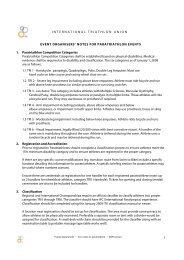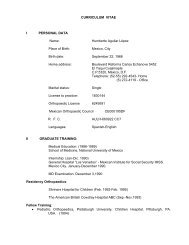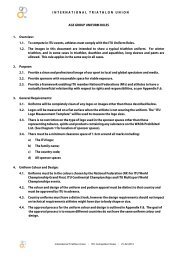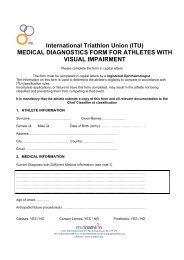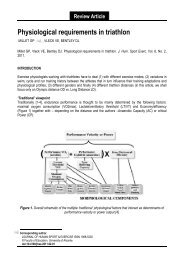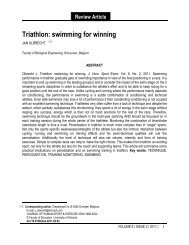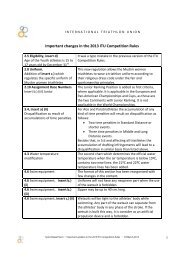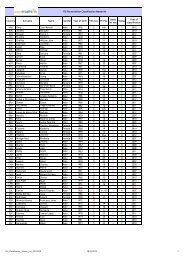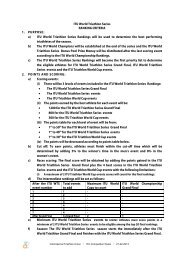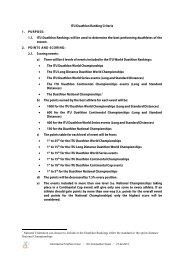ITU Paratriathlon Classification Rules and Regulations 2012 Edition ...
ITU Paratriathlon Classification Rules and Regulations 2012 Edition ...
ITU Paratriathlon Classification Rules and Regulations 2012 Edition ...
You also want an ePaper? Increase the reach of your titles
YUMPU automatically turns print PDFs into web optimized ePapers that Google loves.
10. MEDICAL DEFINITIONS<br />
Locomotor Dysfunction: Profiles 1-32<br />
Sensory Dysfunction: Profiles 36-37<br />
Able Bodied: Profile 48<br />
PROFILE 1:<br />
FOUR LIMBS REDUCED IN FUNCTION. Severe spasticity, athetosis or paresis<br />
present in all limbs <strong>and</strong> trunk. Needs an electric wheelchair or personal<br />
assistant during daily life. Not eligible for paratriathlon if an electric wheelchair<br />
user.<br />
PROFILE 2: FOUR LIMBS REDUCED IN FUNCTION. Severe deformity, paresis or<br />
incoordination present in all limbs <strong>and</strong> trunk. Triceps non-functional against<br />
resistance, e.g. complete C5/6 lesion. Poor trunk control. Not eligible for<br />
paratriathlon if an electric wheelchair user.<br />
PROFILE 3:<br />
PROFILE 4:<br />
PROFILE 5:<br />
PROFILE 6:<br />
PROFILE 7:<br />
PROFILE 8:<br />
FOUR LIMBS REDUCED IN FUNCTION. Moderate deformity, paresis or in<br />
coordination present in all limbs <strong>and</strong> trunk. The finger flexors, extensors <strong>and</strong><br />
intrinsics may be severely impaired, e.g. complete C6/7 lesion. Poor balance<br />
<strong>and</strong> inability to grip <strong>and</strong> release objects. Not eligible for paratriathlon if an<br />
electric wheelchair user.<br />
FOUR LIMBS REDUCED IN FUNCTION. Severe deformity, paresis, or absence of<br />
all limbs. Trunk less affected <strong>and</strong> sensation minimally affected.<br />
FOUR LIMBS REDUCED IN FUNCTION. Moderate spasticity or athetosis present<br />
in all limbs <strong>and</strong> perhaps trunk. Can propel chair with difficulty, either with<br />
arms or legs. Moderate trunk control.<br />
FOUR LIMBS REDUCED IN FUNCTION. Minimal impairment in upper limbs,<br />
severe paresis or spasticity in lower limbs <strong>and</strong> trunk, e.g. complete C8/T1<br />
lesion, or moderate wheelchair quadriplegic. Poor trunk control <strong>and</strong> slighltly<br />
weak h<strong>and</strong>s or lack of control in the arms.<br />
THREE LIMBS REDUCED IN FUNCTION. Severe deformity, paresis, spasticity,<br />
athetosis or absence of three limbs. Some trunk involvement. One limb may<br />
be only minimally affected, but use of a wheelchair is essential. Difficulty with<br />
trunk control.<br />
FOUR LIMBS REDUCED IN FUNCTION. Minimal paresis or spasticity in upper<br />
limbs, <strong>and</strong> moderate to severe spasticity or paresis of lower limbs. Intrinsic<br />
muscles of h<strong>and</strong>s may be severely affected. Trunk normal.<br />
PROFILE 9: LOWER LIMBS AND TRUNK REDUCED IN FUNCTION. Severe spasticity,<br />
athetosis, or deformity present in lower limbs <strong>and</strong> trunk. Unable to balance in<br />
sitting unsupported. (T1 – T5). No lower trunk control.<br />
PROFILE 10:<br />
LOWER LIMBS REDUCED IN FUNCTION. Severe spasticity, athetosis, deformity,<br />
or paresis present in both lower limbs. Moderate trunk involvement (T5 – T10).<br />
Good use of trunk <strong>and</strong> arms, but unable to use hip to assist trunk movement. If<br />
they are unable to move outside their base of support, they can be Profile 9.<br />
22




